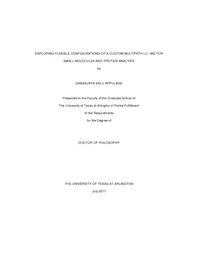| dc.description.abstract | There are diseases where both small molecules and proteins are found as disease indicators. In the usual analysis of small molecules, proteins are precipitated out during the sample preparation. In the small molecule quantitation, triple quadrupole mass spectrometers (QqQ- MS) are commonly used even in the clinical lab settings. Even though QqQ is giving only unit resolution, it is highly sensitive and specific specially when it is used in the multiple reaction monitoring (MRM) mode. In the liquid chromatography method development, automation of column and mobile phase screening could save significant amount of operators’ time. The use of Shimadzu Nexera Method Scouting Solutions software to automate the column and mobile phase screening was evaluated. The selectivity differences among four reversed phase stationary phases, C18, biphenyl, polar embedded (IBD) and pentafluorophenyl propyl (PFPP) were studied using model analyte set which includes analytes from different classes depending on the functionality and physicochemical properties. It has shown that biphenyl phase shows similar selectivity behavior as C18 when acetonitrile is used as the organic mobile phase. Further, use of Type C silica based phases, (cholesterol, bidentate C18, diol and diamond hydride) for the small molecule separation under both reversed-phase as well as aqueous normal phase were explored. Four analytes, fentanyl, hydrocodone, hydromorphone and matrine showed dual mode retention with the all four phases studied. In our lab, new system was developed to analyze both small molecules and proteins simultaneously using QqQ- MS. Model analyte set which includes over 20 small molecules and five proteins, ubiquitin, myoglobin, cytochrome c, lactalbumin, lysozyme were used to prove that the system is working. Both small molecules and proteins were detected simultaneously on Shimadzu LCMS 8050 QqQ-MS using MRM mode. Restricted access media (RAM) columns were used to trap small molecules while excluding proteins in the developed multi-channel system. Among the four RAM columns explored, Shim pack MAYI C8 column gave overall the best exclusion percentage for the proteins explored. Further, two-dimensional liquid chromatography mass spectrometry (2DLC-MS) system was developed in our lab on the same LCMS 8050. Six proteins, ubiquitin, myoglobin, cytochrome c, β-casein, carbonic anhydrase, β-lactoglobulin A were used with same mobile phase in both dimension to prove that the system is working. Different reversed-phase stationary phase columns as well as several mobile phases were evaluated to use as the first-dimension column while keeping Restek ARC 18 column and mobile phases with 0.1% formic acid and 0.05% trifluoroacetic acid for the second-dimension. It has shown that the system is working but could not achieved desired separation with RP x RP combination. Therefore, exploring the use of other modes of liquid chromatography such as hydrophilic interaction chromatography (HIC) column for the first dimension is currently undergoing. | |


